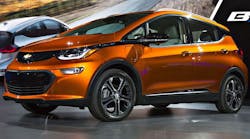General Motors Co. joined a growing group of automakers promising an emissions-free future for cars by pledging to sell 20 all-electric vehicles by 2023.
The largest U.S. automaker, which generates most of its profit with large sport utility vehicles and pickup trucks, plans to have a lineup of both battery-powered cars and hydrogen fuel-cell autos, which also run on electricity. Two new EVs will debut in the next 18 months to follow the Chevrolet Bolt that’s been on sale for less than a year.
“GM believes the future is all electric, a world free of automotive emissions,” Mark Reuss, executive vice president of global product development, said on Oct. 2 at the company’s technical center north of Detroit. “It’s real.”
The planned lineup demonstrates GM is doubling down on electrification despite the Bolt’s slow start in U.S. showrooms and companies’ inability thus far to profitably sell EVs. The automaker has delivered fewer than 12,000 units of the battery-powered Bolt, which goes about 238 miles between charges. Deliveries have primarily been concentrated thus far in California, which mandates sales of emissions-less vehicles.
Carmakers are rushing to develop electric technology to meet tougher regulations around the globe. Almost 50 new pure electric-car models will come to market globally between now and 2022, including vehicles from Daimler AG and Volkswagen AG. Even British inventor James Dyson, known for his vacuums and fans, is getting into the game, announcing last week that he’s investing two billion pounds (US$2.7 billion) to develop an electric car.
China EVs
China, GM’s largest market globally, is moving to cap carbon emissions by 2030, which means automakers will need battery-powered vehicles for the market. Under the country’s cap-and-trade policy, automakers must obtain a new-energy vehicle score -- linked to the production of various types of zero- and low-emission vehicles -- of at least 10% starting in 2019, rising to 12% in 2020, the Ministry of Industry and Information Technology said last week.
GM Chief Executive Officer Mary Barra said last month that GM would have 10 new-energy vehicles in China by 2020. Some of those will be electric cars and others will be plug-in hybrids that still burn gasoline but gain efficiency by being paired with an electric motor.
Reuss said that GM’s electric vehicle program will be profitable. During the company’s first-quarter earnings call, Barra said GM’s lithium-ion batteries cost about $145 per kilowatt hour to produce and that the automaker is targeting less than $100.
Batteries are getting cheaper and lighter, Reuss said. Reducing weight is vital because it means the electric drive system doesn’t have to work as hard. That, in turn, reduces cost as the battery system doesn’t require as much power.
Flipping Switch
Despite GM’s commitment, Reuss said it’s impossible to predict when all new vehicles will have an electric drive in any market. The technology has to improve, the world needs more charging stations and consumers have to accept them, he said.
“This is more than building electric vehicles,” Reuss said. “You can’t just flip a switch and make the world go electric.”
GM showed several concept cars on Oct. 2. The three vehicles for consumers were crossovers for the Buick and Cadillac brands and a model that could be a future version of the Chevrolet Bolt.
The company also showed a large truck concept that uses a fuel cell to generate electricity on board and power two electric motors. The platform, called Silent Utility Rover Universal Superstructure, or SURUS, could be used to build delivery vehicles or ambulances.
The military has been working with GM on its fuel cell platform, which is jointly developed along with Honda Motor Co.
By David Welch



